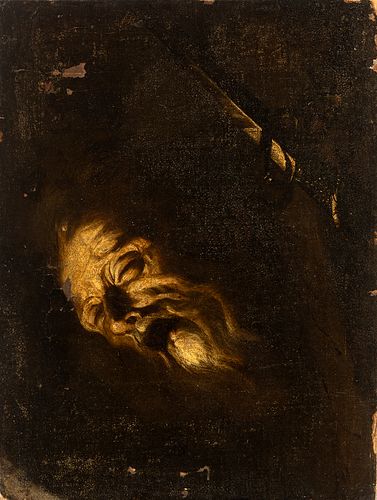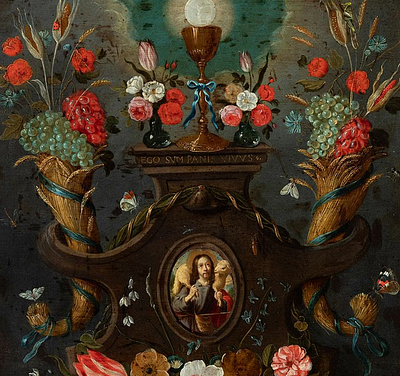SEBASTIÁN LLANOS VALDÉS (ca. 1605-1677). "Head of Saint Paul. Oil on canvas. Re-retouched.
Lot 8
About Seller
Setdart Auction House
Carrer Aragó 346
Barcelona
Spain
Setdart Subastas was born in 2004 and is currently the first online art auction in Spain with solidity, prestige and reliability guaranteed by our more than 60,000 users. Setdart has a young, dynamic and enterprising team ready to successfully manage the purchase and sale of art works through custom...Read more
Estimate:
EUR€700 - EUR€900
$721.65 - $927.84
Absentee vs Live bid
Two ways to bid:
- Leave a max absentee bid and the platform will bid on your behalf up to your maximum bid during the live auction.
- Bid live during the auction and your bids will be submitted real-time to the auctioneer.
Bid Increments
| Price | Bid Increment |
|---|---|
| EUR€0 | EUR€10 |
| EUR€200 | EUR€25 |
| EUR€500 | EUR€50 |
| EUR€1,000 | EUR€100 |
| EUR€3,000 | EUR€200 |
| EUR€5,000 | EUR€500 |
| EUR€10,000 | EUR€1,000 |
| EUR€20,000 | EUR€2,000 |
| EUR€50,000 | EUR€5,000 |
About Auction
By Setdart Auction House
Sep 21, 2021
Set Reminder
2021-09-21 10:00:00
2021-09-21 10:00:00
America/New_York
Bidsquare
Bidsquare : 21st September - ARAS JÁUREGUI Private Collection - Old Masters, 19th & 20th Century
https://www.bidsquare.com/auctions/setdart-auction-house/21st-september---aras-j-uregui-private-collection---old-masters-19th-20th-century-7429
Setdart Auction House sofia@setdart.com
Setdart Auction House sofia@setdart.com
- Lot Description
SEBASTIÁN LLANOS VALDÉS (ca. 1605-1677). "Head of Saint Paul. Oil on canvas. Re-retouched. It presents faults, repainting and xylophagous remains. Measurements: 48,5 x 63,5 cm. In this scene of great dramatism, which follows the tenebrist inheritance, as for the light expressiveness, the author only shows the face of an old man, with closed eyelids and on his right a knife. This iconographic attribute identifies the figure as Saint Paul. Paul was a Hellenised Jew from the Diaspora, born in Tarsus. He was therefore Jewish by ethnicity, Greek by culture and Roman by nationality. He received the name Saul, which he changed to Paul after his conversion. Born at the beginning of the first century, he studied in Jerusalem under the rabbi Gamaliel, who would have been noted for his hatred of Christians. One day, when he was on his way from Jerusalem to Damascus around the year 35, he was dazzled by lightning and fell from his horse. Then he heard the voice of Jesus saying to him: "Saul, Saul, why are you persecuting me? As a result of this experience, the saint went abruptly from persecutor to zealot of Christianity. After curing the blindness of a Christian from Damascus, he began his life as a missionary until he reached Jerusalem, where he came into contact with Peter and the other apostles. In the Middle Ages numerous corporations were placed under his patronage, due to various aspects of his iconography, life and miracles. However, St Paul was never a popular saint, which is proof of the relative poverty of his iconography. In fact, his role in art is not commensurate with his importance in the spread of Christianity. In early Christian art his only attributes are a book or a scroll, and in the 13th century his emblem appears, the sword that was the instrument of his martyrdom. A Spanish Baroque painter, active in Seville and apparently a disciple of Francisco de Herrera the Elder, Sebastián de Llanos Valdés' style shows much influence from Francisco de Zurbarán. He is known to have been Mayor of the Painters' Guild in Seville in 1653 and is assumed (according to contemporary texts) to be well off. He also co-founded the San Lucas Academy of Drawing in 1660, together with Murillo and Herrera el Mozo. His work is preserved in Seville Cathedral, as well as monumental Evangelists in the Casa de Pilatos in the same city.
- Shipping Info
-
In-house shipping available. Please inquire at admin@setdart.com.
-
- Buyer's Premium



 EUR
EUR CAD
CAD AUD
AUD GBP
GBP MXN
MXN HKD
HKD CNY
CNY MYR
MYR SEK
SEK SGD
SGD CHF
CHF THB
THB
















